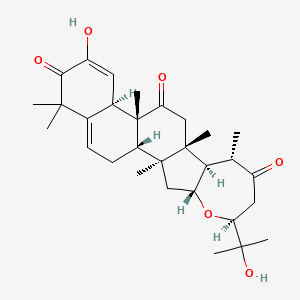| Authors | Title | Published | Journal | PubMed Link |
|---|---|---|---|---|
| Abbas S et al. | The cucurbitacins E, D and I: investigation of their cytotoxicity toward human chondrosarcoma SW 1353 cell line and their biotransformation in man liver. | 2013 | Toxicol. Lett. | pmid:23194827 |
| Tessier AM and Paris RR | [Study of some African toxic euphobiacees containing cucurbitacins (author's transl)]. | 1978 | Toxicol Eur Res | pmid:583587 |
| Paryzek Z and Wydra R | Tetracyclic triterpenes. Part VI [1]. The synthesis of 4,4,14 alpha-trimethyl-19 (10 leads to 9 beta) abeo-steroids. Synthons for the preparation of cucurbitacins. | 1981 | Steroids | pmid:6895428 |
| Lee DH et al. | Cucurbitacin: ancient compound shedding new light on cancer treatment. | 2010 | ScientificWorldJournal | pmid:20209387 |
| Wang Y et al. | Cucurbitacin IIb exhibits anti-inflammatory activity through modulating multiple cellular behaviors of mouse lymphocytes. | 2014 | PLoS ONE | pmid:24587010 |
| Recio MC et al. | Anti-inflammatory activity of two cucurbitacins isolated from Cayaponia tayuya roots. | 2004 | Planta Med. | pmid:15124085 |
| Peters RR et al. | Anti-inflammatory and analgesic effects of cucurbitacins from Wilbrandia ebracteata. | 1997 | Planta Med. | pmid:9434604 |
| Lang KL et al. | New cytotoxic cucurbitacins from Wilbrandia ebracteata Cogn. | 2011 | Planta Med. | pmid:21472651 |
| Arumuggam N et al. | A Review: Phytochemicals Targeting JAK/STAT Signaling and IDO Expression in Cancer. | 2015 | Phytother Res | pmid:25787773 |
| Bhandari P et al. | Cucurbitacins from Bacopa monnieri. | 2007 | Phytochemistry | pmid:17442350 |
Cucurbitacin S
Cucurbitacin s is a lipid of Sterol Lipids (ST) class. The involved functions are known as establishment and maintenance of localization and nitric oxide biosynthetic process.
Cross Reference
Introduction
To understand associated biological information of Cucurbitacin S, we collected biological information of abnormalities, associated pathways, cellular/molecular locations, biological functions, related genes/proteins, lipids and common seen animal/experimental models with organized paragraphs from literatures.
What diseases are associated with Cucurbitacin S?
There are no associated biomedical information in the current reference collection.
No disease MeSH terms mapped to the current reference collection.
PubChem Associated disorders and diseases
What pathways are associated with Cucurbitacin S
There are no associated biomedical information in the current reference collection.
PubChem Biomolecular Interactions and Pathways
Link to PubChem Biomolecular Interactions and PathwaysWhat cellular locations are associated with Cucurbitacin S?
There are no associated biomedical information in the current reference collection.
What functions are associated with Cucurbitacin S?
Related references are published most in these journals:
| Function | Cross reference | Weighted score | Related literatures |
|---|
What lipids are associated with Cucurbitacin S?
There are no associated biomedical information in the current reference collection.
What genes are associated with Cucurbitacin S?
There are no associated biomedical information in the current reference collection.
What common seen animal models are associated with Cucurbitacin S?
There are no associated biomedical information in the current reference collection.
